A New Impedance-Based Main and Backup Protection Scheme for Active Distribution Lines in AC Microgrids
Abstract
1. Introduction
1.1. Network Modifying-Based Schemes
1.2. Protective Strategy-Based Schemes
- Proper operation in both grid-connected and islanded modes
- Independence of network reconfigurations
- High impedance faults detection
- Short response time
- Low sampling rate
- Minimum data exchange
2. Modified Equivalent Circuits for Doubly-Fed Lines During Faults
2.1. Three-Phase Faults
2.2. Line-to-Line Faults
2.3. Single-Line-to-Ground Faults
2.4. Double-Line-to-Ground Faults
3. Proposed Protection Scheme for Distribution Lines
3.1. Main Protection Scheme
3.2. Backup Protection Scheme
4. Case Study
5. Evaluation of the Proposed Protection Schemes
5.1. Main Protection Scheme Evaluation
5.2. Backup Protection Scheme Evaluation
- (a)
- Loads and DGs properties were considered similar to Section 4.
- (b)
- Loads powers in the microgrid were doubled compared to condition “a”.
- (c)
- Loads powers in the microgrid were halved compared to condition “a”.
- (d)
- Loads powers were similar to condition “a” but DG2 and DG3 were disconnected.
6. Conclusions
Author Contributions
Funding
Institutional Review Board Statement
Informed Consent Statement
Data Availability Statement
Acknowledgments
Conflicts of Interest
References
- Mirsaeidi, S.; Said, D.M.; Mustafa, M.W.; Habibuddin, M.H.; Ghaffari, K. Modeling and simulation of a communication-assisted digital protection scheme for micro-grids. Renew. Sustain. Energy Rev. 2016, 57, 867–878. [Google Scholar] [CrossRef]
- Teimourzadeh, S.; Aminifar, F.; Davarpanah, M.; Guerrero, J.M. Macroprotections for Microgrids: Toward a New Protection Paradigm Subsequent to Distributed Energy Resource Integration. IEEE Ind. Electron. Mag. 2016, 10, 6–18. [Google Scholar] [CrossRef]
- Blaabjerg, F.; Yang, Y.; Yang, D.; Wang, X. Distributed Power-Generation Systems and Protection. Proc. IEEE 2017, 105, 1311–1331. [Google Scholar] [CrossRef]
- Jiao, Z.; Jin, J.; Liu, L.; Wang, Y.; Wang, Q.; Wang, Z. A Practical Setting Method for Over-Current Relay and Automatic Recloser in Distribution Network with Photovoltaic Station. Int. J. Electr. Energy. 2015, 3, 225–229. [Google Scholar] [CrossRef]
- Adly, A.R.; El-Sehiemy, R.A.; Abdelaziz, A.Y. Optimal reclosing time to improve transient stability in distribution system. CIRED-Open Access Proc. J. 2017, 2017, 1359–1362. [Google Scholar] [CrossRef]
- Aminifar, F.; Fotuhi-Firuzabad, M.; Safdarian, A.; Davoudi, A.; Shahidehpour, M. Synchrophasor Measurement Technology in Power Systems: Panorama and State-of-the-Art. IEEE Access 2014, 2, 1607–1628. [Google Scholar] [CrossRef]
- Ghanbari, T.; Farjah, E. Unidirectional Fault Current Limiter: An Efficient Interface Between the Microgrid and Main Network. IEEE Trans. Power Syst. 2013, 28, 1591–1598. [Google Scholar] [CrossRef]
- Khederzadeh, M. Preservation of over current relays coordination in microgrids by application of static series compensators. In Proceedings of the 11th Int. Conference on Developments in Power Systems Protection (DPSP), Birmingham, UK, 23–25 April 2012; pp. 1–6. [Google Scholar]
- Dahej, A.E.E.; Esmaeili, S.; Hojabri, H. Co-Optimization of Protection Coordination and Power Quality in Microgrids Using Unidirectional Fault Current Limiters. IEEE Trans. Smart Grid. 2017, 9, 5080–5091. [Google Scholar] [CrossRef]
- Oureilidis, K.O.; Demoulias, C.S. A Fault clearing method in converter-dominated microgrids with conventional protection means. IEEE Trans. Power Electron. 2016, 31, 4628–4640. [Google Scholar] [CrossRef]
- Orji, U.; Schantz, C.; Leeb, S.B.; Kirtley, J.L.; Sievenpiper, B.; Gerhard, K.; McCoy, T. Adaptive Zonal Protection for Ring Microgrids. IEEE Trans. Smart Grid. 2015, 8, 1843–1851. [Google Scholar] [CrossRef]
- Khederzadeh, M. Adaptive setting of protective relays in microgrids in grid-connected and autonomous operation. In Proceedings of the 11th Int. Conference on Developments in Power Systems Protection (DPSP), Birmingham, UK, 23–25 April 2012; pp. 14–20. [Google Scholar]
- Laaksonen, H.; Ishchenko, D.; Oudalov, A. Adaptive protection and microgrid control design for Hailuoto island. IEEE Trans. Smart Grid. 2014, 5, 1486–1493. [Google Scholar] [CrossRef]
- Zeineldin, H.H.; El-Saadany, E.F.; Salama, M.M.A. Distributed Generation Micro-Grid Operation: Control and Protection. In Proceedings of the 2006 Power Systems Conference: Advanced Metering, Protection, Control, Communication, and Distributed Resources, Atlanta, GA, USA, 29 October–1 November 2006; pp. 105–111. [Google Scholar]
- Sortomme, E.; Venkata, S.S.; Mitra, J. Microgrid Protection Using Communication-Assisted Digital Relays. IEEE Trans. Power Deliv. 2010, 25, 2789–2796. [Google Scholar] [CrossRef]
- Aghdam, T.S.; Karegar, H.K.; Zeineldin, H. Variable Tripping Time Differential Protection for Microgrids Considering DG Stability. IEEE Trans. Smart Grid. 2019, 10, 2407–2415. [Google Scholar] [CrossRef]
- Kar, S.; Samantaray, S.R.; Zadeh, M.D. Data-Mining Model Based Intelligent Differential Microgrid Protection Scheme. IEEE Syst. J. 2015, 11, 1161–1169. [Google Scholar] [CrossRef]
- Loix, T.; Wijnhoven, T.; Deconinck, G. Protection of microgrids with a high penetration of inverter-coupled energy sources. In Proceedings of the CIGRE/IEEE PES Joint Symposium Integration of Wide-Scale Renewable Resources Into the Power Delivery System, Calgary, AB, Canada, 29–31 July 2009; pp. 1–8. [Google Scholar]
- Sharma, N.K.; Samantaray, S.R. Assessment of PMU-based wide-area angle criterion for fault detection in microgrid. IET Gener. Transm. Distrib. 2019, 13, 4301–4310. [Google Scholar] [CrossRef]
- Best, R.J.; Morrow, D.J.; Crossley, P.A. Communication assisted protection selectivity for reconfigurable and islanded power networks. In Proceedings of the 44th Int. Universities Power Engineering Conf. (UPEC), Glasgow, UK, 1–4 September 2009; pp. 1–4. [Google Scholar]
- Darabi, A.; Bagheri, M.; Gharehpetian, G.B. Highly sensitive microgrid protection using overcurrent relays with a novel relay characteristic. IET Renew. Power Gener. 2020, 14, 1201–1209. [Google Scholar] [CrossRef]
- Zamani, M.A.; Sidhu, T.S.; Yazdani, A. A Protection Strategy and Microprocessor-Based Relay for Low-Voltage Microgrids. IEEE Trans. Power Deliv. 2011, 26, 1873–1883. [Google Scholar] [CrossRef]
- Furlan, R.H.; Beuter, C.H.; Bataglioli, R.P.; Faria, I.D.M.; Oleskovicz, M. Improvement of overcurrent protection considering distribution systems with distributed generation. In Proceedings of the 2018 18th International Conference on Harmonics and Quality of Power (ICHQP), Ljubljana, Slovenia, 13–16 May 2018; pp. 1–5. [Google Scholar]
- Hooshyar, A.; Iravani, R. Microgrid Protection. Proc. IEEE 2017, 105, 1332–1353. [Google Scholar] [CrossRef]
- Nikolaidis, V.C.; Tsimtsios, A.M.; Safigianni, A.S. Investigating Particularities of Infeed and Fault Resistance Effect on Distance Relays Protecting Radial Distribution Feeders With DG. IEEE Access 2018, 6, 11301–11312. [Google Scholar] [CrossRef]
- Bottrell, N.; Green, T.C. An impedance-based method for the detection of over-load and network faults in inverter interfaced distributed generation. In Proceedings of the 2013 15th European Conference on Power Electronics and Applications (EPE), Lille, France, 3–5 September 2013; pp. 1–10. [Google Scholar]
- Huang, W.; Nengling, T.; Zheng, X.; Fan, C.; Yang, X.; Kirby, B.J. An Impedance Protection Scheme for Feeders of Active Distribution Networks. IEEE Trans. Power Deliv. 2014, 29, 1591–1602. [Google Scholar] [CrossRef]
- Pandakov, K.; Hidalen, H.K. Distance protection with fault impedance compensation for distribution network with DG. In Proceedings of the IEEE PES Innovative Smart Grid Technologies Conf. Europe (ISGT-Europe), Torino, Italy, 26–29 September 2017. [Google Scholar]
- Biller, M.; Jaeger, J. Voltage-Free Distance Protection Method for Closed Loop Structures. In Proceedings of the 2018 IEEE PES Innovative Smart Grid Technologies Conference Europe (ISGT-Europe), Sarajevo, Bosnia and Herzegovina, 21–25 October 2018; pp. 1–6. [Google Scholar]
- Fang, Y.; Jia, K.; Yang, Z.; Li, Y.; Bi, T. Impact of Inverter-Interfaced Renewable Energy Generators on Distance Protection and an Improved Scheme. IEEE Trans. Ind. Electron. 2018, 66, 7078–7088. [Google Scholar] [CrossRef]



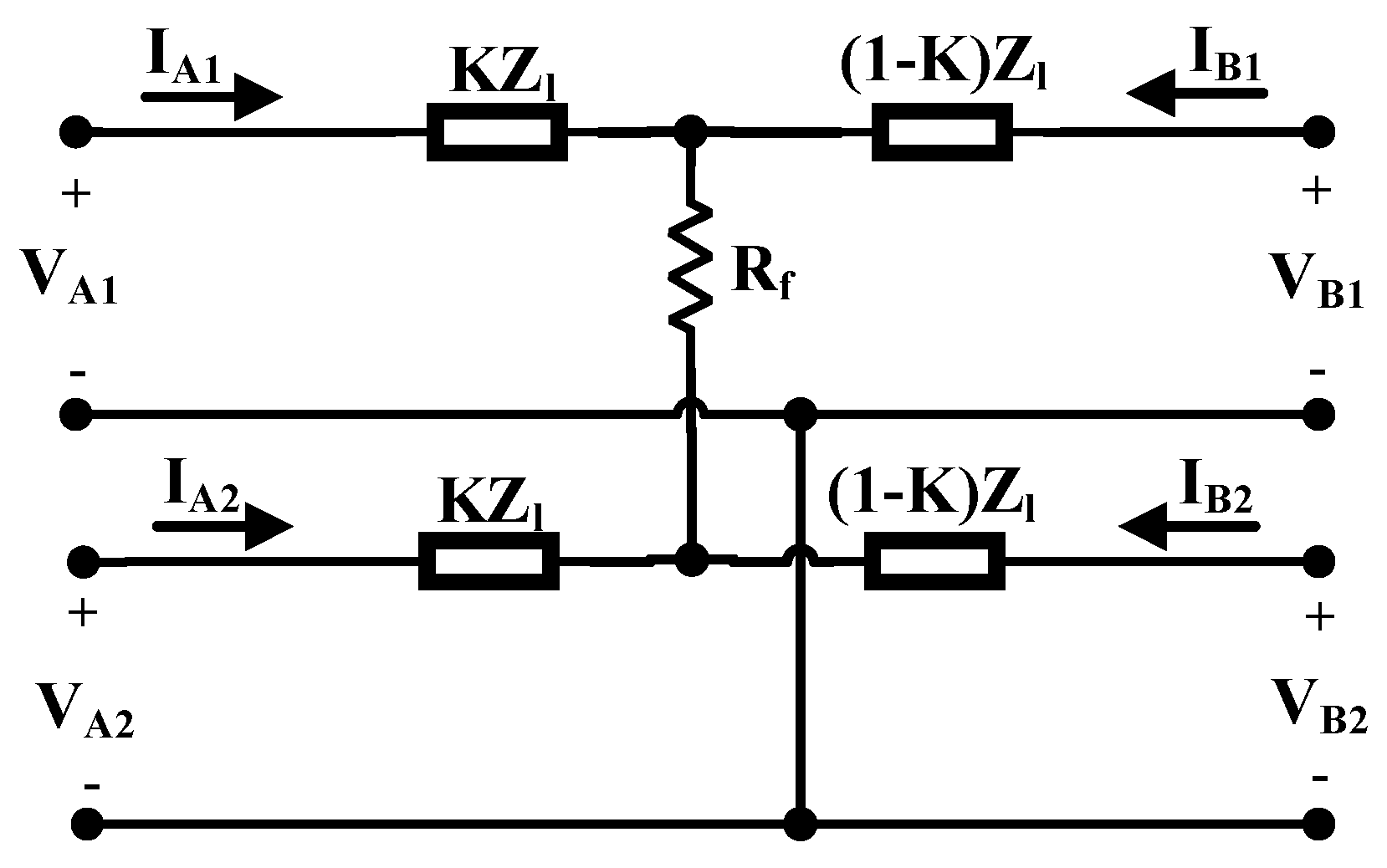



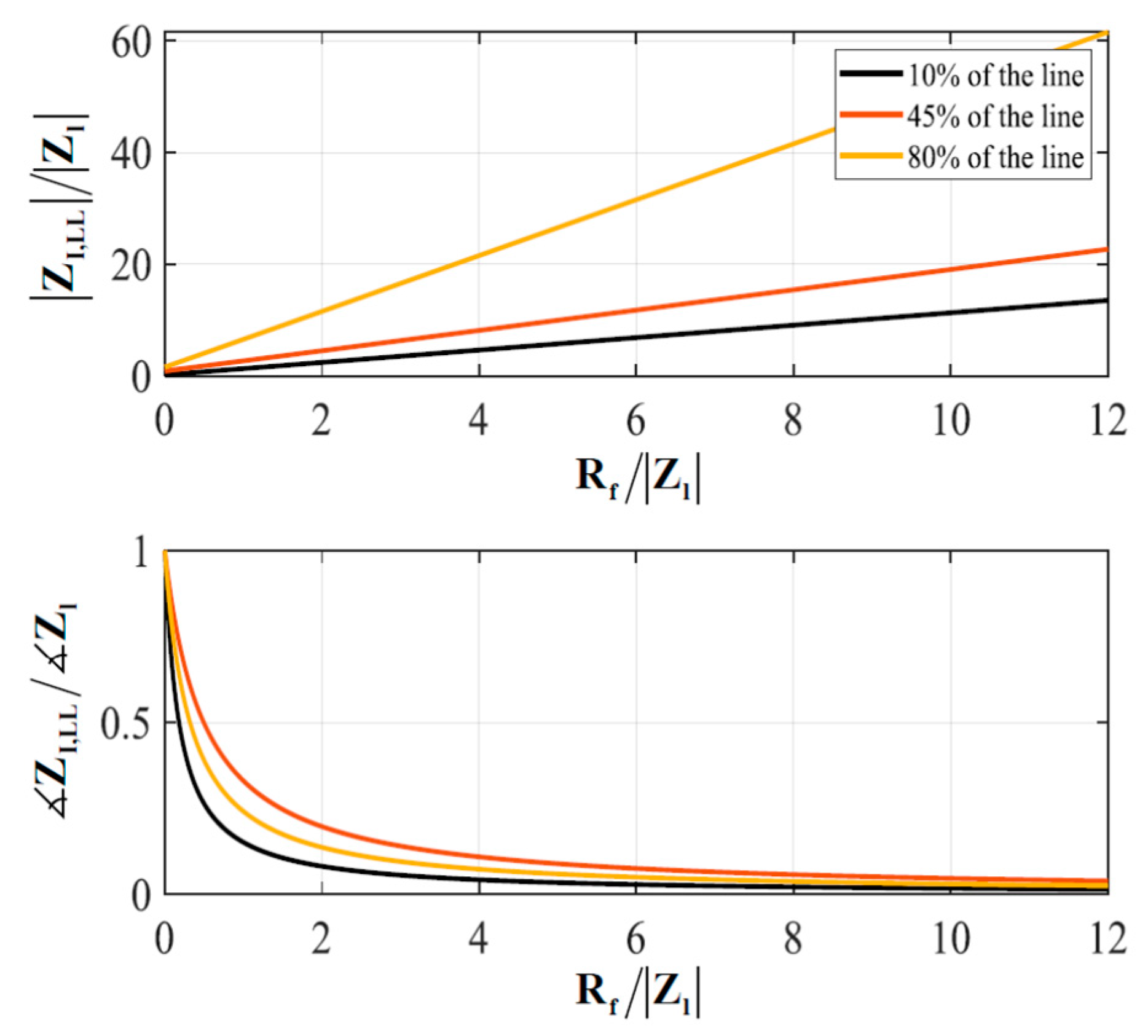
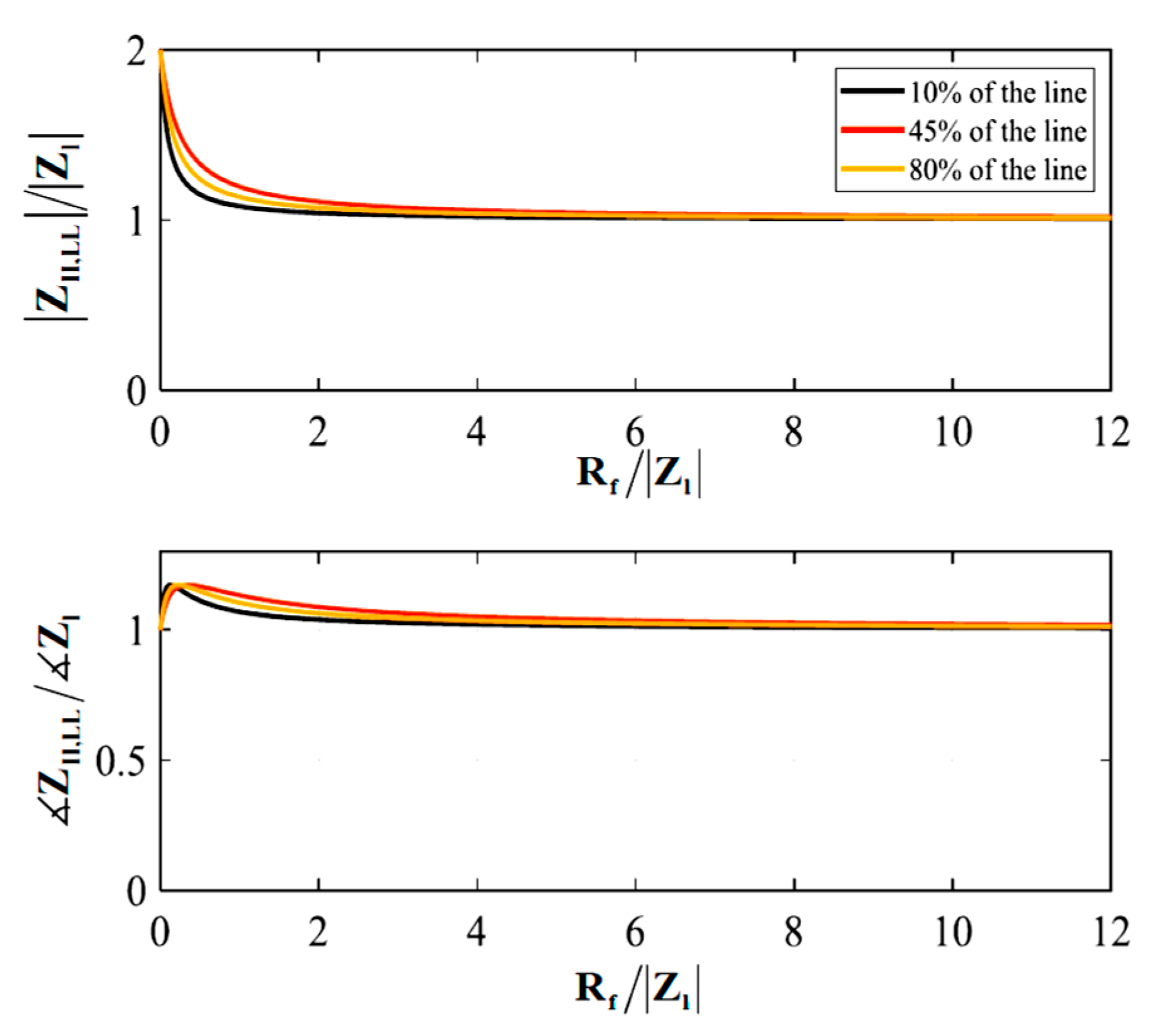
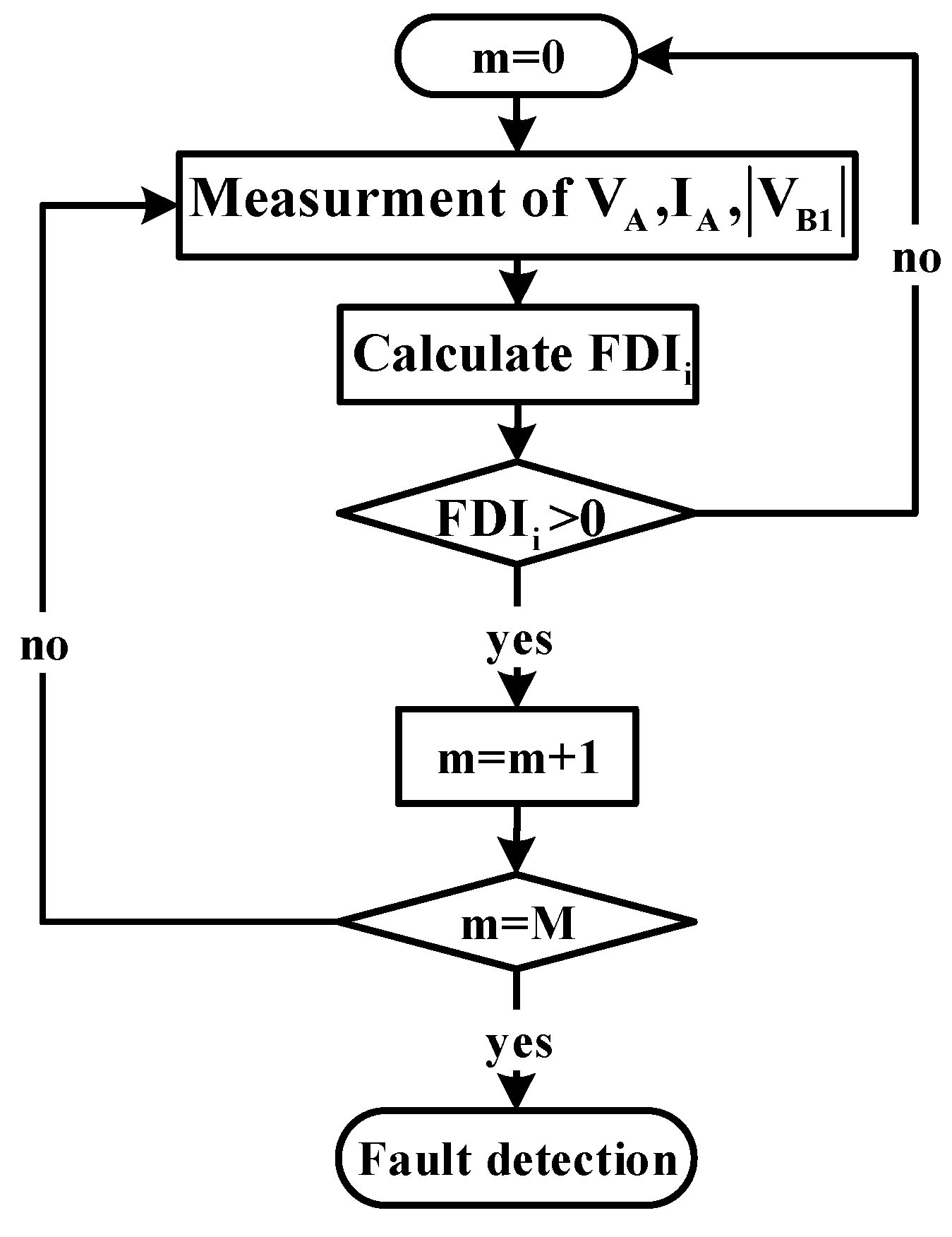





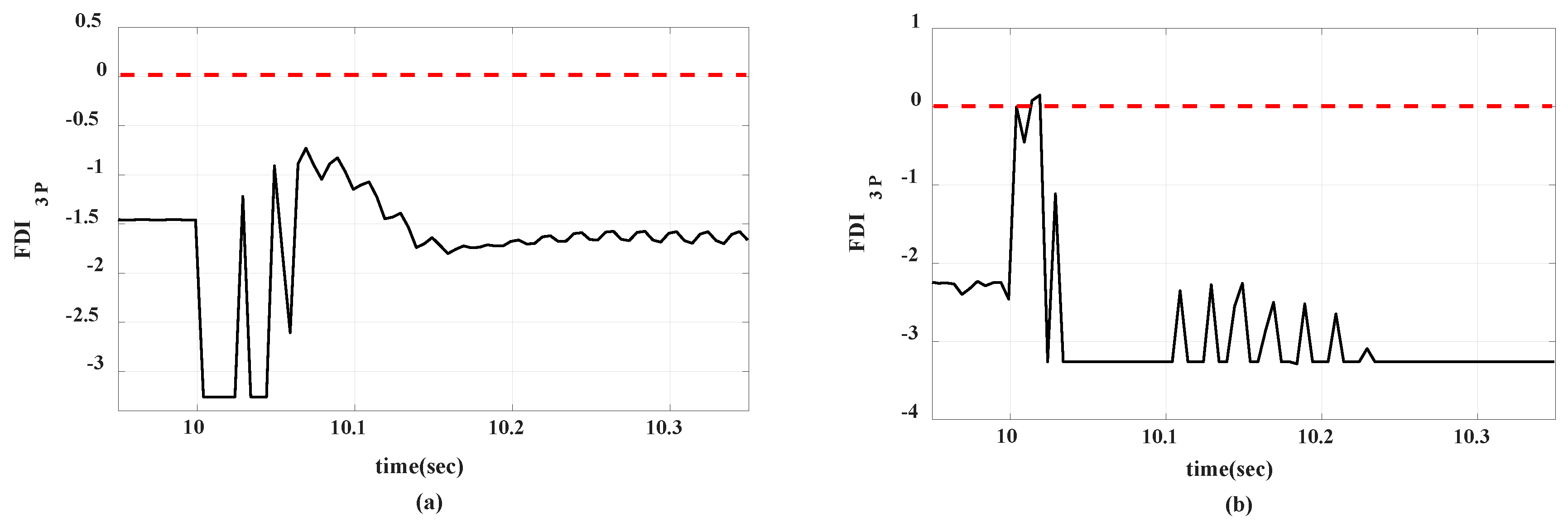
| Operation Mode | Fault Type- Fault Res. | Fault Location | Inside the Prot. Zone | FDI3P | Correct Perf. | Resp. Time (ms). |
|---|---|---|---|---|---|---|
| Grid-connected | 3P-0.01Ω | 10% of Line 4 | Yes | 3.94 | ✓ | 30 |
| 50% of Line 4 | Yes | 4.06 | ✓ | 30 | ||
| 90% of Line 4 | Yes | 3.21 | ✓ | 35 | ||
| 10% of Line 3 | No | TP | ✓ | - | ||
| 10% of Line 5 | No | TP | ✓ | - | ||
| 3P-1Ω | 10% of Line 4 | Yes | 2.69 | ✓ | 30 | |
| 50% of Line 4 | Yes | 2.43 | ✓ | 30 | ||
| 90% of Line 4 | Yes | 1.72 | ✓ | 30 | ||
| 3P-10Ω | 10% of Line 4 | Yes | 1.7 | ✓ | 30 | |
| 50% of Line 4 | Yes | 1.44 | ✓ | 30 | ||
| 90% of Line 4 | Yes | 0.74 | ✓ | 35 | ||
| 3P-50Ω | 10% of Line 4 | Yes | 1 | ✓ | 30 | |
| 50% of Line 4 | Yes | 0.75 | ✓ | 35 | ||
| 90% of Line 4 | Yes | 0.05 | ✓ | 50 | ||
| Islanded | 3P-0.01Ω | 10% of Line 4 | Yes | 4.63 | ✓ | 30 |
| 50% of Line 4 | Yes | 4.21 | ✓ | 30 | ||
| 90% of Line 4 | Yes | 3.46 | ✓ | 30 | ||
| 10% of Line 3 | No | TP | ✓ | - | ||
| 10% of Line 5 | No | TP | ✓ | - | ||
| 3P-1Ω | 10% of Line 4 | Yes | 2.69 | ✓ | 30 | |
| 50% of Line 4 | Yes | 2.44 | ✓ | 30 | ||
| 90% of Line 4 | Yes | 1.73 | ✓ | 30 | ||
| 3P-10Ω | 10% of Line 4 | Yes | 1.69 | ✓ | 30 | |
| 50% of Line 4 | Yes | 1.44 | ✓ | 30 | ||
| 90% of Line 4 | Yes | 0.74 | ✓ | 30 | ||
| 3P-50Ω | 10% of Line 4 | Yes | 1 | ✓ | 30 | |
| 50% of Line 4 | Yes | 0.74 | ✓ | 35 | ||
| 90% of Line 4 | Yes | 0.04 | ✓ | 45 |
| Operation Mode | Fault Type- Fault Res. | Fault Location | Inside the Prot. Zone | FDIDLG | Correct Perf. | Resp. Time (ms). |
|---|---|---|---|---|---|---|
| Grid-connected | DLG-0.01Ω | 10% of Line 4 | Yes | 3.75 | ✓ | 30 |
| 50% of Line 4 | Yes | 3.7 | ✓ | 30 | ||
| 90% of Line 4 | Yes | 2.79 | ✓ | 40 | ||
| 10% of Line 3 | No | TP | ✓ | - | ||
| 10% of Line 5 | No | Negative | ✓ | - | ||
| DLG-1Ω | 10% of Line 4 | Yes | 2.69 | ✓ | 30 | |
| 50% of Line 4 | Yes | 2.42 | ✓ | 30 | ||
| 90% of Line 4 | Yes | 1.7 | ✓ | 30 | ||
| DLG-10Ω | 10% of Line 4 | Yes | 1.69 | ✓ | 30 | |
| 50% of Line 4 | Yes | 1.44 | ✓ | 30 | ||
| 90% of Line 4 | Yes | 0.74 | ✓ | 40 | ||
| DLG-50Ω | 10% of Line 4 | Yes | 1 | ✓ | 30 | |
| 50% of Line 4 | Yes | 0.74 | ✓ | 35 | ||
| 90% of Line 4 | Yes | 0.05 | ✓ | 50 | ||
| Islanded | DLG-0.01Ω | 10% of Line 4 | Yes | 4.48 | ✓ | 30 |
| 50% of Line 4 | Yes | 3.85 | ✓ | 30 | ||
| 90% of Line 4 | Yes | 2.96 | ✓ | 30 | ||
| 10% of Line 3 | No | TP | ✓ | - | ||
| 10% of Line 5 | No | TP | ✓ | - | ||
| DLG-1Ω | 10% of Line 4 | Yes | 2.69 | ✓ | 30 | |
| 50% of Line 4 | Yes | 2.43 | ✓ | 30 | ||
| 90% of Line 4 | Yes | 1.72 | ✓ | 30 | ||
| DLG-10Ω | 10% of Line 4 | Yes | 1.69 | ✓ | 30 | |
| 50% of Line 4 | Yes | 1.44 | ✓ | 30 | ||
| 90% of Line 4 | Yes | 0.73 | ✓ | 30 | ||
| DLG-50Ω | 10% of Line 4 | Yes | 1 | ✓ | 30 | |
| 50% of Line 4 | Yes | 0.74 | ✓ | 30 | ||
| 90% of Line 4 | Yes | 0.04 | ✓ | 40 |
| Operation Mode | Fault Type- Fault Res. | Fault Location | Inside the Prot. Zone | FDILL | Correct Perf. | Resp. Time (ms). |
|---|---|---|---|---|---|---|
| Grid-connected | LL-0.01Ω | 10% of Line 4 | Yes | 4.47 | ✓ | 30 |
| 50% of Line 4 | Yes | 3.82 | ✓ | 30 | ||
| 90% of Line 4 | Yes | 2.92 | ✓ | 40 | ||
| 10% of Line 3 | No | TP | ✓ | - | ||
| 10% of Line 5 | No | Negative | ✓ | - | ||
| LL-1Ω | 10% of Line 4 | Yes | 2.69 | ✓ | 30 | |
| 50% of Line 4 | Yes | 2.43 | ✓ | 30 | ||
| 90% of Line 4 | Yes | 1.72 | ✓ | 40 | ||
| LL-10Ω | 10% of Line 4 | Yes | 1.69 | ✓ | 30 | |
| 50% of Line 4 | Yes | 1.44 | ✓ | 30 | ||
| 90% of Line 4 | Yes | 0.74 | ✓ | 40 | ||
| LL-50Ω | 10% of Line 4 | Yes | 1 | ✓ | 30 | |
| 50% of Line 4 | Yes | 0.74 | ✓ | 35 | ||
| 90% of Line 4 | Yes | 0.05 | ✓ | 50 | ||
| Islanded | LL-0.01Ω | 10% of Line 4 | Yes | 4.54 | ✓ | 30 |
| 50% of Line 4 | Yes | 3.93 | ✓ | 30 | ||
| 90% of Line 4 | Yes | 2.99 | ✓ | 30 | ||
| 10% of Line 3 | No | TP | ✓ | - | ||
| 10% of Line 5 | No | TP | ✓ | - | ||
| LL-1Ω | 10% of Line 4 | Yes | 2.69 | ✓ | 30 | |
| 50% of Line 4 | Yes | 2.43 | ✓ | 30 | ||
| 90% of Line 4 | Yes | 1.72 | ✓ | 30 | ||
| LL-10Ω | 10% of Line 4 | Yes | 1.69 | ✓ | 30 | |
| 50% of Line 4 | Yes | 1.44 | ✓ | 30 | ||
| 90% of Line 4 | Yes | 0.74 | ✓ | 30 | ||
| LL-50Ω | 10% of Line 4 | Yes | 1 | ✓ | 30 | |
| 50% of Line 4 | Yes | 0.74 | ✓ | 30 | ||
| 90% of Line 4 | Yes | 0.04 | ✓ | 40 |
| Operation Mode | Fault type- Fault Res. | Fault Location | Inside the Prot. Zone | FDISLG | Correct Perf. | Resp. Time (ms). |
|---|---|---|---|---|---|---|
| Grid-connected | SLG-0.01Ω | 10% of Line 4 | Yes | 4.5 | ✓ | 30 |
| 50% of Line 4 | Yes | 3.91 | ✓ | 30 | ||
| 90% of Line 4 | Yes | 3.08 | ✓ | 35 | ||
| 10% of Line 3 | No | TP | ✓ | - | ||
| 10% of Line 5 | No | TP | ✓ | - | ||
| SLG-1Ω | 10% of Line 4 | Yes | 2.69 | ✓ | 30 | |
| 50% of Line 4 | Yes | 2.43 | ✓ | 30 | ||
| 90% of Line 4 | Yes | 1.73 | ✓ | 35 | ||
| SLG-10Ω | 10% of Line 4 | Yes | 1.69 | ✓ | 30 | |
| 50% of Line 4 | Yes | 1.44 | ✓ | 30 | ||
| 90% of Line 4 | Yes | 0.74 | ✓ | 45 | ||
| SLG-50Ω | 10% of Line 4 | Yes | 1 | ✓ | 30 | |
| 50% of Line 4 | Yes | 0.75 | ✓ | 35 | ||
| 90% of Line 4 | Yes | 0.07 | ✓ | 45 | ||
| Islanded | SLG-0.01Ω | 10% of Line 4 | Yes | 4.53 | ✓ | 30 |
| 50% of Line 4 | Yes | 3.97 | ✓ | 30 | ||
| 90% of Line 4 | Yes | 3.02 | ✓ | 35 | ||
| 10% of Line 3 | No | TP | ✓ | - | ||
| 10% of Line 5 | No | TP | ✓ | - | ||
| SLG-1Ω | 10% of Line 4 | Yes | 2.69 | ✓ | 30 | |
| 50% of Line 4 | Yes | 2.43 | ✓ | 30 | ||
| 90% of Line 4 | Yes | 1.73 | ✓ | 35 | ||
| SLG-10Ω | 10% of Line 4 | Yes | 1.69 | ✓ | 30 | |
| 50% of Line 4 | Yes | 1.44 | ✓ | 35 | ||
| 90% of Line 4 | Yes | 0.74 | ✓ | 35 | ||
| SLG-50Ω | 10% of Line 4 | Yes | 0.99 | ✓ | 35 | |
| 50% of Line 4 | Yes | 0.74 | ✓ | 35 | ||
| 90% of Line 4 | Yes | 0.05 | ✓ | 50 |
| Operation Mode | Fault Type-Fault Res. | Fault Location | Inside the Prot. Zone | FDIi | Correct Perf. | Resp. Time (ms). |
|---|---|---|---|---|---|---|
| Grid-connected | 3P-50Ω | 90% of Line 4 | Yes | 0.029 | ✓ | 50 |
| DLG-50Ω | 90% of Line 4 | Yes | 0.029 | ✓ | 50 | |
| LL-50Ω | 90% of Line 4 | Yes | 0.027 | ✓ | 50 | |
| SLG-50Ω | 90% of Line 4 | Yes | 0.014 | ✓ | 45 | |
| Islanded | 3P-50Ω | 90% of Line 4 | Yes | 0.035 | ✓ | 50 |
| DLG-50Ω | 90% of Line 4 | Yes | 0.038 | ✓ | 40 | |
| LL-50Ω | 90% of Line 4 | Yes | 0.037 | ✓ | 40 | |
| SLG-50Ω | 90% of Line 4 | Yes | 0.027 | ✓ | 50 |
| Operation Mode | Fault Type/Load | Fault/Load Location | CVI | Fault Recog. by the Proposed Scheme | Correct Perf. of Proposed Scheme | Correct Perf. of Scheme in [27]. |
|---|---|---|---|---|---|---|
| Grid-connected | 3P | 10% of Line 3 | 0.01 | No | ✓ | ✓ |
| 90% of Line 4 | 0.49 | Yes | ✓ | ✕ | ||
| 90% of Line 5 | 0.47 | Yes | ✓ | ✕ | ||
| DLG | 10% of Line 3 | −0.04 | No | ✓ | ✓ | |
| 90% of Line 4 | 1.38 | Yes | ✓ | ✕ | ||
| 90% of Line 5 | 1.22 | Yes | ✓ | ✕ | ||
| LL | 10% of Line 3 | 0 | No | ✓ | ✓ | |
| 90% of Line 4 | 0.92 | Yes | ✓ | ✕ | ||
| 90% of Line 5 | 0.83 | Yes | ✓ | ✕ | ||
| SLG | 10% of Line 3 | −0.03 | No | ✓ | ✓ | |
| 90% of Line 4 | 0.57 | Yes | ✓ | ✕ | ||
| 90% of Line 5 | 0.33 | Yes | ✓ | ✕ | ||
| load | 100% of Line 5 | 0.17 | No | ✓ | ✓ | |
| Islanded | 3P | 10% of Line 3 | −0.16 | No | ✓ | ✓ |
| 90% of Line 4 | 0.33 | Yes | ✓ | ✕ | ||
| 90% of Line 5 | 0.31 | Yes | ✓ | ✕ | ||
| DLG | 10% of Line 3 | −0.55 | No | ✓ | ✓ | |
| 90% of Line 4 | 0.90 | Yes | ✓ | ✓ | ||
| 90% of Line 5 | 0.80 | Yes | ✓ | ✓ | ||
| LL | 10% of Line 3 | −0.37 | No | ✓ | ✓ | |
| 90% of Line 4 | 0.59 | Yes | ✓ | ✕ | ||
| 90% of Line 5 | 0.53 | Yes | ✓ | ✓ | ||
| SLG | 10% of Line 3 | −0.23 | No | ✓ | ✓ | |
| 90% of Line 4 | 0.42 | Yes | ✓ | ✓ | ||
| 90% of Line 5 | 0.23 | Yes | ✓ | ✕ | ||
| load | 100% of Line 5 | 0.11 | No | ✓ | ✓ |
| Operation Mode | Fault Type/Load | Fault/Load Location | CVI | Fault Recog. by the Proposed Scheme | Correct Perf. of Proposed Scheme | Correct Perf. of Scheme in [27]. |
|---|---|---|---|---|---|---|
| Grid-connected | 3P | 10% of Line 3 | 0 | No | ✓ | ✓ |
| 90% of Line 4 | 0.46 | Yes | ✓ | ✕ | ||
| 90% of Line 5 | 0.44 | Yes | ✓ | ✕ | ||
| DLG | 10% of Line 3 | −0.03 | No | ✓ | ✓ | |
| 90% of Line 4 | 1.30 | Yes | ✓ | ✓ | ||
| 90% of Line 5 | 1.13 | Yes | ✓ | ✕ | ||
| LL | 10% of Line 3 | −0.03 | No | ✓ | ✓ | |
| 90% of Line 4 | 0.86 | Yes | ✓ | ✕ | ||
| 90% of Line 5 | 0.76 | Yes | ✓ | ✕ | ||
| SLG | 10% of Line 3 | −0.03 | No | ✓ | ✓ | |
| 90% of Line 4 | 0.55 | Yes | ✓ | ✕ | ||
| 90% of Line 5 | 0.31 | Yes | ✓ | ✕ | ||
| load | 100% of Line 5 | 0.16 | No | ✓ | ✓ | |
| Islanded | 3P | 10% of Line 3 | −0.16 | No | ✓ | ✓ |
| 90% of Line 4 | 0.32 | Yes | ✓ | ✕ | ||
| 90% of Line 5 | 0.30 | Yes | ✓ | ✕ | ||
| DLG | 10% of Line 3 | −0.52 | No | ✓ | ✓ | |
| 90% of Line 4 | 0.80 | Yes | ✓ | ✕ | ||
| 90% of Line 5 | 0.78 | Yes | ✓ | ✓ | ||
| LL | 10% of Line 3 | −0.37 | No | ✓ | ✓ | |
| 90% of Line 4 | 0.59 | Yes | ✓ | ✕ | ||
| 90% of Line 5 | 0.52 | Yes | ✓ | ✕ | ||
| SLG | 10% of Line 3 | −0.23 | No | ✓ | ✓ | |
| 90% of Line 4 | 0.42 | Yes | ✓ | ✕ | ||
| 90% of Line 5 | 0.22 | Yes | ✓ | ✕ | ||
| load | 100% of Line 5 | 0.11 | No | ✓ | ✓ |
| Operation Mode | Fault Type/Load | Fault/Load Location | CVI | Fault Recog. by the Proposed Scheme | Correct Perf. of Proposed Scheme | Correct Perf. of Scheme in [27]. |
|---|---|---|---|---|---|---|
| Grid-connected | 3P | 10% of Line 3 | 0 | No | ✓ | ✓ |
| 90% of Line 4 | 0.49 | Yes | ✓ | ✕ | ||
| 90% of Line 5 | 0.47 | Yes | ✓ | ✕ | ||
| DLG | 10% of Line 3 | −0.03 | No | ✓ | ✕ | |
| 90% of Line 4 | 1.37 | Yes | ✓ | ✓ | ||
| 90% of Line 5 | 1.23 | Yes | ✓ | ✓ | ||
| LL | 10% of Line 3 | −0.02 | No | ✓ | ✓ | |
| 90% of Line 4 | 0.92 | Yes | ✓ | ✕ | ||
| 90% of Line 5 | 0.84 | Yes | ✓ | ✕ | ||
| SLG | 10% of Line 3 | −0.02 | No | ✓ | ✓ | |
| 90% of Line 4 | 0.57 | Yes | ✓ | ✕ | ||
| 90% of Line 5 | 0.34 | Yes | ✓ | ✓ | ||
| load | 100% of Line 5 | 0.18 | No | ✓ | ✓ | |
| Islanded | 3P | 10% of Line 3 | −0.16 | No | ✓ | ✓ |
| 90% of Line 4 | 0.33 | Yes | ✓ | ✕ | ||
| 90% of Line 5 | 0.32 | Yes | ✓ | ✕ | ||
| DLG | 10% of Line 3 | −0.53 | No | ✓ | ✓ | |
| 90% of Line 4 | 0.88 | Yes | ✓ | ✓ | ||
| 90% of Line 5 | 0.79 | Yes | ✓ | ✕ | ||
| LL | 10% of Line 3 | −0.37 | No | ✓ | ✓ | |
| 90% of Line 4 | 0.60 | Yes | ✓ | ✓ | ||
| 90% of Line 5 | 0.54 | Yes | ✓ | ✓ | ||
| SLG | 10% of Line 3 | −0.24 | No | ✓ | ✓ | |
| 90% of Line 4 | 0.42 | Yes | ✓ | ✓ | ||
| 90% of Line 5 | 0.23 | Yes | ✓ | ✕ | ||
| load | 100% of Line 5 | 0.11 | No | ✓ | ✓ |
| Operation Mode | Fault Type/Load | Fault/Load Location | CVI | Fault Recog. by the Proposed Scheme | Correct Perf. of Proposed Scheme | Correct Perf. of Scheme in [27]. |
|---|---|---|---|---|---|---|
| Grid-connected | 3P | 10% of Line 3 | 0 | No | ✓ | ✓ |
| 90% of Line 4 | 0.50 | Yes | ✓ | ✓ | ||
| 90% of Line 5 | 0.42 | Yes | ✓ | ✓ | ||
| DLG | 10% of Line 3 | 0 | No | ✓ | ✓ | |
| 90% of Line 4 | 1.42 | Yes | ✓ | ✓ | ||
| 90% of Line 5 | 1.26 | Yes | ✓ | ✓ | ||
| LL | 10% of Line 3 | 0 | No | ✓ | ✓ | |
| 90% of Line 4 | 0.95 | Yes | ✓ | ✓ | ||
| 90% of Line 5 | 0.88 | Yes | ✓ | ✓ | ||
| SLG | 10% of Line 3 | 0 | No | ✓ | ✓ | |
| 90% of Line 4 | 0.85 | Yes | ✓ | ✓ | ||
| 90% of Line 5 | 0.77 | Yes | ✓ | ✓ | ||
| load | 100% of Line 5 | 0.17 | No | ✓ | ✓ |
Publisher’s Note: MDPI stays neutral with regard to jurisdictional claims in published maps and institutional affiliations. |
© 2021 by the authors. Licensee MDPI, Basel, Switzerland. This article is an open access article distributed under the terms and conditions of the Creative Commons Attribution (CC BY) license (http://creativecommons.org/licenses/by/4.0/).
Share and Cite
Nobakhti, S.M.; Ketabi, A.; Shafie-khah, M. A New Impedance-Based Main and Backup Protection Scheme for Active Distribution Lines in AC Microgrids. Energies 2021, 14, 274. https://doi.org/10.3390/en14020274
Nobakhti SM, Ketabi A, Shafie-khah M. A New Impedance-Based Main and Backup Protection Scheme for Active Distribution Lines in AC Microgrids. Energies. 2021; 14(2):274. https://doi.org/10.3390/en14020274
Chicago/Turabian StyleNobakhti, Seyyed Mohammad, Abbas Ketabi, and Miadreza Shafie-khah. 2021. "A New Impedance-Based Main and Backup Protection Scheme for Active Distribution Lines in AC Microgrids" Energies 14, no. 2: 274. https://doi.org/10.3390/en14020274
APA StyleNobakhti, S. M., Ketabi, A., & Shafie-khah, M. (2021). A New Impedance-Based Main and Backup Protection Scheme for Active Distribution Lines in AC Microgrids. Energies, 14(2), 274. https://doi.org/10.3390/en14020274






